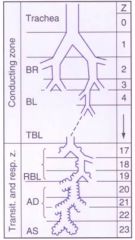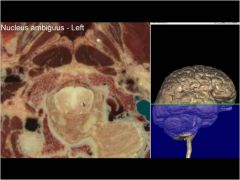![]()
![]()
![]()
Use LEFT and RIGHT arrow keys to navigate between flashcards;
Use UP and DOWN arrow keys to flip the card;
H to show hint;
A reads text to speech;
21 Cards in this Set
- Front
- Back

|

Upper 16 branches are in the conducting zone; no exchange of gas between atmosphere and blood
Last 7 branching points = gas exchange |
|
|
Nasal Receptor Activation
|
via trigeminal nerves; results in sneezing
|
|
|
Nasopharyngeal receptors
|
via glossopharyngeal nerves; results in aspiration or sniff reflex
|
|
|
Laryngeal and tracheal receptors
|
via vagus nerves; results in coughing
|
|

|

Nucleus ambiguus; cough center in brain in medulla; found approximately in same area as respiratory center/cardiovascular control center
|
|
|
Sympathetic nerve NT
|
NE
|
|

B/C = bronchioconstriction
B/D = bronchiodilation |
Efferent Nerves, Transmitters, and REceptors
|
|
|
ACE Inhibitors and Cough
|
Cough side effect; accumulation of bradykinin and prostaglandins sensitize cough receptors
Best action for ACE inhibitor cough is to discontinue tx and replace it with an angiotensin-II receptor antagonist |
|
|
Mechanics of Cough
|
Rapid air inspiration; epiglottis closes tightly; abs/intracostal muscles contract to increase lung pressure; epiglottis opens suddenly and air is expelled at a velocity of up to 100 MPH
Usually stimulated by signals sent to cough center (medulla/nucleus ambiguus) via vagus nerve |
|
|
Sneeze
|
Same mechanism as cough except during sneeze, uvula is depressed so air is expelled through the nose
|
|
|
where are cough receptors highest in density
|
branch points in the tracheobronchial tree and mucosa of the larynx; these are sites where particles are most likely to be deposited
|
|
|
what happens when macrophages can't digest a particle
|
they release proteases that will productive an activation of lung fibroblasts and attract leukocytes that results in permanent lung damage if it occurs over a long period of time
|
|
|
Hypoxic Pulmonary Vasoconstriction
|
Region of lung underperfused will not receive blood vessels (since no gas exchange would take place); the response is due to a local effect of hypoxia on the vessel itself and not central occur (likely due to P02 of the alveolas gas and NOT pulmonary arterial blood that determines this response)
|
|
|
Hypoxic Pulmonary Vasoconstriction at high altitudes
|
the pulmonary vasoconstriction is throughout the lungs and results in increased pulmonary artery pressure; causes a thickening of the right ventricle wall; can cause pulmonary edema and individuals may develop chronic mountain sickness if an individual is not taken to lower elevations
|
|
|
Compare the location of the cough center in the brain to the centers that help regulate respiration and the cardiovascular center.
|
Same area; gives us an indication of how important the cough center was as our brain was developing; cough must be crucial for our long term existence
|
|
|
Explain why pharmacological companies have attempted to develop “inhalers” that produce particles in the size range of 1-3 mm?
|
Inhalers with smaller particles can deliver drug to lower regions of the respiratory tree; although often the problem is upper airway constriction so it sometimes doesn't matter; still the companies are seeking to improve drug delivery to respiratory system
|
|
|
Explain the potential problem that can develop if a person with asthma is give an beta-blocker to treat CHF.
|
B-blockers are useful for tx htn and CHF; however the circulating epinephrine is important in keeping airways dilated; if a B blocker is given to a pt with asthma or propensity towards developing asthma airway constriction may develop and asthma symptoms may occur
|
|
|
Why are atropine like drugs useful in treating patients with asthma?
|
Parasympathetic nerves release ACh; blocking Ach prevents constriction of airways
Atropine = muscarinic antagonist |
|
|
Why do people at high altitude develop a thickened right ventricular wall?
|
Hypoxic regions of lung have decreased perfusion; this is normally to keep blood from going to region sof lung that are not well ventilated; at high altitude the entire lung is not well ventilated because of decreased alveolar P02 and entire lung becomes constricted; increases pulmonary artery pressure which over time will lead to a thickening of right ventricle wall as the heart tries to push against this increased pulmonary resistance
|
|
|
Why is the central respiratory center depressed when a person travels to high altitude?
|
At high altitude = hyperventilation; blow off C02 = decreased C02 levels depress respiratory center; however the need for oxygen overcomes this and an individual will continue to hyperventilate
|
|
|
How many branches occur in the airways of the lungs before oxygen can be exchanged with the blood?
|
Upper 16 = dead space of alveoli = conducting = can't exchange gas
Lower 7 branching points are capable of exchanging gases |

